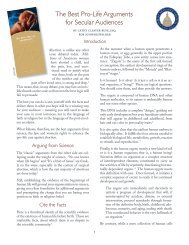The Effects of Divorce on Children - Family Research Council
The Effects of Divorce on Children - Family Research Council
The Effects of Divorce on Children - Family Research Council
You also want an ePaper? Increase the reach of your titles
YUMPU automatically turns print PDFs into web optimized ePapers that Google loves.
experienced a transiti<strong>on</strong> are predicted to never end a marriage, compared to those<br />
who experienced three or more transiti<strong>on</strong>s, whose likelihood to never divorce is<br />
about 33 percent. 166<br />
Daughters <str<strong>on</strong>g>of</str<strong>on</strong>g> divorced parents divorce more than s<strong>on</strong>s <str<strong>on</strong>g>of</str<strong>on</strong>g> divorced parents do. 167<br />
<str<strong>on</strong>g>The</str<strong>on</strong>g> risk <str<strong>on</strong>g>of</str<strong>on</strong>g> divorce in the first five years is 70 168 to 76 169 percent higher for the<br />
daughters <str<strong>on</strong>g>of</str<strong>on</strong>g> divorced parents than for daughters <str<strong>on</strong>g>of</str<strong>on</strong>g> intact marriages. 170<br />
Marital Behaviors. Parental divorce is also associated with lower marital<br />
quality for their children. This manifests itself in arguing more about the<br />
family, 171 increased rates <str<strong>on</strong>g>of</str<strong>on</strong>g> jealousy, moodiness, infidelity, c<strong>on</strong>flicts over m<strong>on</strong>ey,<br />
excessive drinking, and drug use. 172 Analysis <str<strong>on</strong>g>of</str<strong>on</strong>g> the 1987-1988 wave <str<strong>on</strong>g>of</str<strong>on</strong>g> the<br />
Nati<strong>on</strong>al Survey <str<strong>on</strong>g>of</str<strong>on</strong>g> Families and Households showed that children <str<strong>on</strong>g>of</str<strong>on</strong>g> divorce<br />
whose marriages were less than “very happy” communicated less and were more<br />
than twice as likely to argue frequently and to shout and hit when they argued. 173<br />
<str<strong>on</strong>g>The</str<strong>on</strong>g> child with an available father, both in the early and the adolescent years, is<br />
more compani<strong>on</strong>able and resp<strong>on</strong>sible as an adult. 174 In particular, “boys who feel<br />
close to their fathers, regardless <str<strong>on</strong>g>of</str<strong>on</strong>g> biological status, have better attitudes about<br />
intimacy and the prospect <str<strong>on</strong>g>of</str<strong>on</strong>g> their own married lives than boys who do not feel<br />
close to their fathers.” 175<br />
166<br />
Nicholas H. Wolfinger, “Bey<strong>on</strong>d the Intergenerati<strong>on</strong>al Transmissi<strong>on</strong> <str<strong>on</strong>g>of</str<strong>on</strong>g> <str<strong>on</strong>g>Divorce</str<strong>on</strong>g>: Do People<br />
Replicate the Patterns <str<strong>on</strong>g>of</str<strong>on</strong>g> Marital Instability <str<strong>on</strong>g>The</str<strong>on</strong>g>y Grew Up With?” Journal <str<strong>on</strong>g>of</str<strong>on</strong>g> <strong>Family</strong> Issues<br />
21, no. 8 (2000): 1075.<br />
167<br />
Norval D. Glenn and Kathryn B. Kramer, “<str<strong>on</strong>g>The</str<strong>on</strong>g> Marriages and <str<strong>on</strong>g>Divorce</str<strong>on</strong>g>s <str<strong>on</strong>g>of</str<strong>on</strong>g> the <strong>Children</strong> <str<strong>on</strong>g>of</str<strong>on</strong>g><br />
<str<strong>on</strong>g>Divorce</str<strong>on</strong>g>,” Journal <str<strong>on</strong>g>of</str<strong>on</strong>g> Marriage and <strong>Family</strong> 49 (1987): 811-825.<br />
168<br />
Paul R. Amato, “Explaining the Intergenerati<strong>on</strong>al Transmissi<strong>on</strong> <str<strong>on</strong>g>of</str<strong>on</strong>g> <str<strong>on</strong>g>Divorce</str<strong>on</strong>g>,” Journal <str<strong>on</strong>g>of</str<strong>on</strong>g><br />
Marriage and <strong>Family</strong> 58 (1996): 628.<br />
169<br />
Paul R. Amato and Alan Booth, A Generati<strong>on</strong> at Risk (Cambridge, MA: Harvard University<br />
Press, 1997), 115.<br />
170 According to Amato and Booth’s research, the risk is highest when the divorce takes place<br />
before the child reaches age 13. <str<strong>on</strong>g>The</str<strong>on</strong>g> risk that the child will divorce decreases significantly when<br />
their parents’ divorce takes place during the teen years. Finally, parental divorce when their<br />
<str<strong>on</strong>g>of</str<strong>on</strong>g>fspring are in their twenties may even inoculate them against divorce. See Paul Amato,<br />
“Explaining the Intergenerati<strong>on</strong>al Transmissi<strong>on</strong> <str<strong>on</strong>g>of</str<strong>on</strong>g> <str<strong>on</strong>g>Divorce</str<strong>on</strong>g>,” Journal <str<strong>on</strong>g>of</str<strong>on</strong>g> Marriage and <strong>Family</strong> 58<br />
(1996): 638.<br />
171 Susan G. Timmer and Joseph Ver<str<strong>on</strong>g>of</str<strong>on</strong>g>f, “<strong>Family</strong> Ties and the Disc<strong>on</strong>tinuity <str<strong>on</strong>g>of</str<strong>on</strong>g> <str<strong>on</strong>g>Divorce</str<strong>on</strong>g> in Black<br />
and White Newlywed Couples,” Journal <str<strong>on</strong>g>of</str<strong>on</strong>g> Marriage and <strong>Family</strong> 62 (2000): 349-361.<br />
172 Paul R. Amato and Stacy Rogers, “A L<strong>on</strong>gitudinal Study <str<strong>on</strong>g>of</str<strong>on</strong>g> Marital Problems and Subsequent<br />
<str<strong>on</strong>g>Divorce</str<strong>on</strong>g>,” Journal <str<strong>on</strong>g>of</str<strong>on</strong>g> Marriage and <strong>Family</strong> 59 (1997): 621.<br />
173 Pamela S. Webster, Terri L. Orbuch, and James S. House, “<str<strong>on</strong>g>Effects</str<strong>on</strong>g> <str<strong>on</strong>g>of</str<strong>on</strong>g> Childhood <strong>Family</strong><br />
Background <strong>on</strong> Adult Marital Quality and Perceived Stability,” American Journal <str<strong>on</strong>g>of</str<strong>on</strong>g> Sociology<br />
101 (1995): 404-432.<br />
174 John Snarey, How Fathers Care for the Next Generati<strong>on</strong> (Cambridge, MA: Harvard University<br />
Press, 1993), 163-164.<br />
175 Shar<strong>on</strong> C. Risch, Kathleen M. Jodl, and Jacquelynne S. Eccles, “Role <str<strong>on</strong>g>of</str<strong>on</strong>g> the Father-Adolescent<br />
Relati<strong>on</strong>ship in Shaping Adolescents’ Attitudes Toward <str<strong>on</strong>g>Divorce</str<strong>on</strong>g>,” Journal <str<strong>on</strong>g>of</str<strong>on</strong>g> Marriage and the<br />
<strong>Family</strong> 66 (2004): 55.<br />
25




